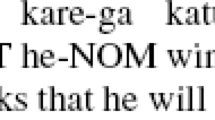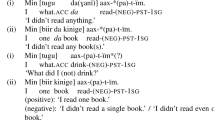This paper examines the question of how so-called indeterminate phrases in Japanese (Kuroda 1965) associate with relevant particles higher in the structure. In the universal construction in Japanese, the restrictor (provided by an indeterminate phrase) sometimes appears to be separate from the universal particle mo. It is proposed that quantification at a distance is only apparent, and that the restriction is in fact provided locally by the sister constituent of mo as a whole. The proposal leads us to a straightforward uniform picture of the syntax-semantics mapping of the universal construction and wh-questions, building upon Hamblin’s (1973) semantics for wh-phrases as sets of alternatives. It allows for a switch of perspective on a long-standing puzzle regarding locality effects in the indeterminate–particle association by deriving the locality pattern from the way indeterminate phrases are interpreted and associated with particles, without any stipulations.
Similar content being viewed by others
References
J. Aoun Y.-H.A. Li (1993) ArticleTitle‘Wh-Elements in Situ: Syntax or LF?’ Linguistic Inquiry 24 199–238
K. Arregi (2003) ArticleTitle‘Clausal Pied-Piping’ Natural Language Semantics 11 115–143 Occurrence Handle10.1023/A:1024499226731
C.L. Baker (1970) ArticleTitle‘Notes on the Description of English Questions: The Role of an Abstract Question Morpheme’ Foundations of Language 6 197–219
S. Beck H. Rullmann (1999) ArticleTitle‘A Flexible Approach to Exhaustivity in Questions’ Natural Language Semantics 7 249–298 Occurrence Handle10.1023/A:1008373224343
Berman, S. (1991). On the Semantics and Logical Form of WH-Clauses, PhD dissertation, University of Massachusetts, Amherst.
Carlson, G. (1977). Reference to Kinds in English, PhD dissertation, University of Massachusetts, Amherst.
G. Chierchia (1998) ArticleTitle‘Reference to Kinds Across Languages’ Natural Language Semantics 6 339–405 Occurrence Handle10.1023/A:1008324218506
J.-W. Choe (1987) ArticleTitle‘LF Movement and Pied-Piping’ Linguistic Inquiry 18 348–353
N. Chomsky (1977) ‘On Wh-Movement’ P. Culicover T. Wasow A. Akmajian (Eds) Formal Syntax Academic Press New York 71–132
Deguchi, M. and Y. Kitagawa (2002). ‘Prosody and Wh-questions’, in M. Hirotani (ed.), Proceedings of the North East Linguistic Society 32, pp. 73–92. GLSA, University of Massachusetts, Amherst.
Dowty, D. and B. Brodie (1984). ‘The Semantics of ‘Floated’ Quantifiers in a Tranformationless Grammar’, in M. Cobler, S. MacKaye, and M.T. Wescoat (eds.), Proceedings of the Third West Coast Conference on Formal Linguistics, pp. 75–90. CSLI Publications, Stanford University.
G. Evans (1980) ArticleTitle‘Pronouns’ Linguistic Inquiry 11 337–362
K. Fukushima (1991) ArticleTitle‘Phrase Structure Grammar, Montague Semantics, and Floating Quantifiers in Japanese’ Linguistics and Philosophy 14 581–628 Occurrence Handle10.1007/BF00631961
K. Fukushima (1993) ArticleTitle‘Model Theoretic Semantics for Japanese Floating Quantifiers and Their Scope Properties’ Journal of East Asian Linguistics 2 213–228 Occurrence Handle10.1007/BF01739133
J. Groenendijk M. Stokhof (1982) ArticleTitle‘Semantic Analysis of Wh-Complements’ Linguistics and Philosophy 5 175–233
Hagstrom, P. (1998). Decomposing Questions, PhD dissertation, MIT.
C.L. Hamblin (1973) ArticleTitle‘Questions in Montague English’ Foundations of Language 10 41–53
Haspelmath M. (1995). ‘Diachronic Sources of ‘All’ and ‘Every”. In: Bach E., Jelinek E., A.Kratzer, and B.H. Partee (eds.), Quantification in Natural Languages. pp. 363–382. Kluwer, Dordrecht.
M. Haspelmath (1997) Indefinite Pronouns Oxford University Press Oxford
Heim, I. (1982). The Semantics of Definite and Indefinite Noun Phrases, PhD dissertation, University of Massachusetts, Amherst.
Heim, I. (1994). ‘Interrogative Semantics and Karttunen’s Semantics for Know’, in R. Buchalla and A. Mittwoch (eds.), IATL 1, pp. 128–144. Akademon, Jerusalem.
G. Hermon (1984) Syntactic Modularity Foris Dordrecht
Hirotani, M. (2003). ‘Prosodic Effects on the Interpretation of Japanese Wh-questions’, in L. Alonso-Ovalle (ed.), On Semantic Processing (University of Massachusetts Occasional Papers in Linguistics 27), pp. 117–137. GLSA, University of Massachusetts, Amherst.
Hoji, H. (1985). Logical Form Constraints and Configurational Structures in Japanese, PhD dissertation, University of Washington.
Huang, C.-T. J. (1982). Logical Relations in Chinese and the Theory of Grammar, PhD dissertation, MIT.
Ishihara, S. (2003). Intonation and Interface Conditions, PhD dissertation, MIT.
Kamp, H. (1981). ‘A Theory of Truth and Semantic Representation’, in J. Groenendijk, T. Janssen, and M. Stokhof (eds.), Formal Methods in the Study of Language, Mathematical Centre Tracts 135, pp. 277–322. Mathematisch Centrum, Amsterdam. Reprinted in J. Groenendijk, T. Janssen, and M. Stokhof (eds.), (1984) Truth, Interpretation and Information, pp. 1–41. Foris, Dordrecht.
L. Karttunen (1977) ArticleTitle‘Syntax and Semantics of Questions’ Linguistics and Philosophy 1 3–44 Occurrence Handle10.1007/BF00351935
E.L. Keenan J. Stavi (1986) ArticleTitle‘A Semantic Characterization of Natural Language Determiners’ Linguistics and Philosophy 9 253–326 Occurrence Handle10.1007/BF00630273
Kim, J.-Y. (2002). ‘Specific Nominals in Chinese and Korean’, Paper presented at GLOW in Asia (2002). National Tsing-Hua University.
A. Kratzer (1998) ‘Scope or Pseudo-Scope? Are There Wide-Scope Indefinites?’ Rothstein Susan (Eds) Events in Grammar Kluwer Dordrecht 163–196
Kratzer, A. (2006). ‘Indefinites and the Operators They Depend on: From Japanese to Salish’, in G.N. Carlson and F. J. Pelletier (eds.), Reference and Quantification: The Partee Effect, CSLI Publications, Stanford.
Kratzer, A. and J. Shimoyama (2002). ‘Indeterminate Pronouns: The View from Japanese’, in Yukio Otsu (ed.), The Proceedings of the Third Tokyo Conference on Psycholinguistics, pp. 1–25. Hituzi Syobo, Tokyo.
Kuroda, S.-Y. (1965). Generative Grammatical Studies in the Japanese Language, PhD dissertation, MIT.
H. Lasnik M. Saito (1992) Move α: Conditions on Its Application and Output MIT Press Cambridge, Mass
Y.-H.A. Li (1992) ArticleTitle‘Indefinite Wh in Mandarin Chinese’ Journal of East Asian Linguistics 1 125–155 Occurrence Handle10.1007/BF00130234
Lin, J.-W. (1996). Polarity Licensing and Wh-phrase Quantification in Chinese, PhD dissertation, University of Massachusetts, Amherst.
L. Matthewson (1999) ArticleTitle‘On the Interpretation of Wide-Scope Indefinites’ Natural Language Semantics 7 79–134 Occurrence Handle10.1023/A:1008376601708
R. May (1985) Logical Form: Its Structure and Derivation MIT Press Cambridge Mass
F. Moltmann (1995) ArticleTitle‘Exception Sentences and Polyadic Quantification’ Linguistics and Philosophy 18 223–280 Occurrence Handle10.1007/BF00985445
T. Nishigauchi (1990) Quantification in the Theory of Grammar Kluwer Dordrecht
Ochi, M. (1999). Constraints on Feature Checking, PhD dissertation, University of Connecticut.
Ohno, Y. (1989). ‘Mo’, in E. Bach, A. Kratzer, and B.H. Partee (eds.), Papers on Quantification, NSF Grant Report, Department of Linguistics, University of Massachusetts, Amherst, pp. 224–250. GLSA, University of Massachusetts, Amherst.
Y. Ohno (1991) ‘Arguments against Unselective Binding in Korean’ S. Kuno (Eds) et al. Harvard Studies in Korean Linguistics IV Hanshin Publishing Seoul 553–562
Ortiz de Urbina, J. (1990). ‘Operator Feature Percolation and Clausal Pied-Piping’, in L. Cheng and H. Demirdash (eds.), Papers on Wh-movement (MIT Working Papers in Linguistics 13), pp. 193–208. MITWPL, Cambridge, Mass.
Pesetsky, D. (1987). ‘Wh-in-Situ: Movement and Unselective Binding’, in E. Reuland and A. ter Meulen (eds.), The Representation of (In)definiteness, pp. 98–129. MIT Press, Cambridge, Mass.
Ramchand, G.C. (1997). ‘Questions, Polarity and Alternative Semantics’, in K. Kusumoto (ed.), Proceedings of the North East Linguistic Society 27, pp. 383–396. GLSA, University of Massachusetts, Amherst.
T. Reinhart (1997) ArticleTitle‘Quantifier Scope: How Labor is Divided between QR and Choice Functions’ Linguistics and Philosophy 20 335–397 Occurrence Handle10.1023/A:1005349801431
T. Reinhart (1998) ArticleTitle‘Wh-in-Situ in the Framework of the Minimalist Program’ Natural Language Semantics 6 29–56 Occurrence Handle10.1023/A:1008240014550
Richards, N. (1997). What Moves Where When in Which Language? PhD dissertation, MIT.
N. Richards (2000) ArticleTitle‘An Island Effect in Japanese’ Journal of East Asian Linguistics 9 187–205 Occurrence Handle10.1023/A:1008342011424
L. Rizzi (1990) Relativized Minimality MIT Press Cambridge, Mass
Rooth, M. (1985). Association with Focus, PhD dissertation, University of Massachusetts, Amherst.
M. Rooth (1996) ‘Focus’ S. Lappin (Eds) The Handbook of Contemporary Semantic Theory Blackwell Oxford 271–297
Sharvit, Y. (1998). ‘Possessive Wh-Expressions and Reconstruction’, in P.N. Tamanji and K. Kusumoto (eds.), Proceedings of the North East Linguistic Society 28, pp. 409–423. GLSA, University of Massachusetts, Amherst.
Shimoyama, J. (1999). ‘Complex NPs and Wh-Quantification in Japanese’, in P.N. Tamanji, M. Hirotani, and N. Hall (eds.), Proceedings of the North East Linguistic Society 29, pp. 355–365. GLSA, University of Massachusetts, Amherst.
Shimoyama, J. (2001). Wh-Constructions in Japanese, PhD dissertation, University of Massachusetts, Amherst.
Shimoyama, J. (2004). ‘Wide Scope Universal NPIs in Japanese’, talk presented at GURT (2004). Georgetown University.
A. Stechow Particlevon (1996) ArticleTitle‘Against LF Pied-Piping’ Natural Language Semantics 4 57–110 Occurrence Handle10.1007/BF00263537
Suzuki, S. (2003). ‘Additive Mo’, ms., MIT.
D. Takahashi (2002) ArticleTitle‘Determiner Raising and Scope Shift’ Linguistic Inquiry 33 575–615 Occurrence Handle10.1162/002438902762731772
H. Tanaka (1999) ArticleTitle‘LF Wh-islands and the Minimal Scope Principle’ Natural Language and Linguistic Theory 17 371–402 Occurrence Handle10.1023/A:1006192709855
Tancredi, C. and M. Yamashina (2002). ‘Wh-setsu-to mo-no dooteki-soogokankei [The Dynamics of Wh-Mo Interaction]’, in T. Ito (ed.), Bunpoo-riron: Rekishikon-to Toogo [Grammatical Theory: Lexicon and Syntax], pp. 273–299. University of Tokyo Press, Tokyo.
Toyoshima, T. (1996). ‘LF Subjacency and Stationary Wh-in-Situ’, ms., Cornell University.
Tsai, W.-T. (1994). On Economizing the Theory of A-Bar Dependencies, PhD dissertation, MIT.
Watanabe, A.: 1992a, ‘Wh-in-Situ, Subjacency, and Chain Formation’, MIT Occasional Papers in Linguistics 2, MITWPL, Cambridge, Mass.
A. Watanabe (1992b) ArticleTitle‘Subjacency and S-structure Movement of Wh-in-Situ’ Journal of East Asian Linguistics 1 255–291 Occurrence Handle10.1007/BF00130554
A. Watanabe (2001) ‘Wh-in-situ Languages’ M. Baltin C. Collins (Eds) The Handbook of Contemporary Syntactic Theory Blackwell Oxford 203–225
A. Watanabe (2004) ArticleTitle‘The Genesis of Negative Concord: Syntax and Morphology of Negative Doubling’ Linguistic Inquiry 35 559–612 Occurrence Handle10.1162/0024389042350497
Y. Winter (1997) ArticleTitle‘Choice Functions and the Scopal Semantics of Indefinites’ Linguistics and Philosophy 20 399–467 Occurrence Handle10.1023/A:1005354323136
Wold, D.E. (1996). ‘Long Distance Selective Binding: The Case of Focus’, in T. Galloway and J. Spence (eds.), Proceedings from Semantics and Linguistic Theory VI, pp. 311–328. CLC Publications, Cornell University.
Yatsushiro, K. (2004). ‘Mo and Ka’, ms., University of Connecticut.
Yoshida, T. (1999). ‘LF Subjacency Effects Revisited’, in V. Lin, C. Krause, B. Bruening, and K. Arregi (eds.), Papers on Morphology and Syntax, Cycle Two (MIT Working Papers in Linguistics 34), pp. 1–34. MITWPL, Cambridge, Mass.
Author information
Authors and Affiliations
Corresponding author
Additional information
This paper is partially based on part of my dissertation submitted to the University of Massachusetts, Amherst. I am most grateful to those who are acknowledged there, and I would in particular like to repeat my gratitude to Angelika Kratzer for discussions, comments and most of all, encouragement. I would also like to thank Kyle Johnson, Bernhard Schwarz, and a reviewer for very useful comments. All remaining inadequacies are my own.
Rights and permissions
About this article
Cite this article
Shimoyama, J. Indeterminate Phrase Quantification in Japanese. Nat Lang Semantics 14, 139–173 (2006). https://doi.org/10.1007/s11050-006-0001-5
Issue Date:
DOI: https://doi.org/10.1007/s11050-006-0001-5




